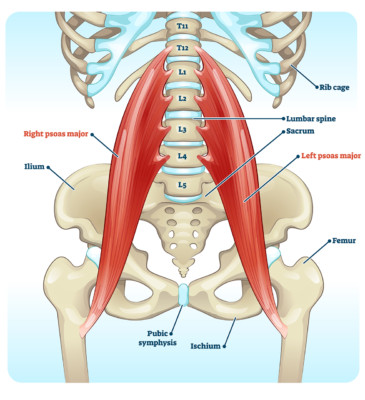Lost Low Back Curve: Why Too Little or Too Much Curve May be Causing Back Pain
The body is intricately and precisely designed, and every structure has a purpose. The spine may be the most important structure in our body for without it our bodies would flop around like a rag doll, unsupported, and our delicate bundle of nerves that connects our central nervous system to the rest of our body would be unprotected. When you think of a support structure, you might envision a house beam or a post, with straight, solid, immovable columns, but the spinal column is built for movement and balance, to distribute our weight, and to withstand a variety of forces, and as such, it has natural, opposing curves. These curves can become compromised via a variety of issues, such as an injury, disc problems, arthritis, normal wear and tear, excessive forces, fusion surgery, and so on. This can lead to lost low back curve, which can cause back pain.
Today I’m going to explain how balancing the psoas muscle and the quadratus lumborum (QL) muscle can help with too little or too much curve in the back and ease back pain. Be sure to watch the video above as the images I walk you through there will aid in your understanding of the anatomy as you read through this post.
The Structure of Spine
There are 24 vertebrae, or backbones, that form the foundation of the spinal structure. These vertebrae stack one on top of the other, and the spinal column stretches from the neck to the lower back. Between each vertebra lives a disc, and the each vertebra meets the next in the back at the facet joint. The spinal cord lives inside the canal that runs through the center of the vertebral column. This cord is a big bundle of nerves, and it transmits feeling and directs our muscles. The column is held together by ligaments, and it is all kept stable by a series of muscles called multifidus.
The Psoas and the Quadratus Lumborum

VectorMine/Shutterstock
Psoas and quadratus lumborum may sound a bit like words used in a potion spell straight out of Hogwarts, but they are muscles that connect our spine to our ilium (the large upper part of the pelvis bone). The muscles start at the spine in the rib area and stretch all the way down to the hip, connecting at various points along the way. There is a front, or anterior, muscle—the psoas; there is also a back, or posterior, muscle—the quadratus lumborum. So, basically, these muscles provide front-back balance for each other, like guide-wires holding up a sailboat mast.
Lost Low Back Curve: The Importance of Balancing the Psoas and Quadratus Lumborum
There is an image in the video that shows a side-view slice of the spine. In it, you can see these two muscles, the psoas coming up at the anterior of the spine, and the QL coming up at the posterior of the spine. You can see that if one is weak or in spasm, we’re going to have different things happen to the spine, depending on which muscle it is. If we have the back muscle (QL) weak or in spasm and pulling too much, that’s going to decrease the back and neck curve and lead to more pressure on the discs. If we have the front muscle (psoas) weak or in spasm and pulling too much, that’s going to increase that curve and put more pressure on the facet joint.
Since lost low back curve is a major factor in back pain, there are a number of ways you can balance the psoas and QL. If you have too little curve, you need to strengthen the psoas muscle or see if there is a pinched nerve making the psoas weak. If you have too much curve, you need to strengthen the QL muscle or see if there is a pinched nerve making the QL weak. In both cases, the following treatments may be able to address weaknesses and spasms in either muscle:
- Massage
- Myofascial release
- Rolfing
- Trigger point dry needling
- Platelet rich plasma injections
The upshot? The opposing curves in the spine are there for mobility, balance, and support. Limiting or stopping mobility or straightening segments of the spine should never be a go-to solution for back pain as this disrupts the precise purpose of the spine. This can only lead to a domino effect of problems down the line, so if lost low back curve, meaning too little or too much curve in your spine is causing your back pain, strengthen your psoas and QL muscles, and look at treatments that will support your natural spinal curves.

NOTE: This blog post provides general information to help the reader better understand regenerative medicine, musculoskeletal health, and related subjects. All content provided in this blog, website, or any linked materials, including text, graphics, images, patient profiles, outcomes, and information, are not intended and should not be considered or used as a substitute for medical advice, diagnosis, or treatment. Please always consult with a professional and certified healthcare provider to discuss if a treatment is right for you.
